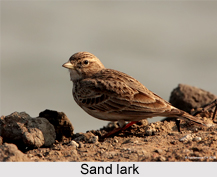 Sand Lark is an Indian bird that bears a scientific name of "Calandrella raytal" and looks similar to the lark family birds.
Sand Lark is an Indian bird that bears a scientific name of "Calandrella raytal" and looks similar to the lark family birds.
Concentration of Sand Lark
Sand Lark is resident in the river valleys of South Asia from Iran through sub-Himalayan India to Burma. It is somewhat similar, but smaller than, the short-toed lark. In the past it has also been referred to as the India Short-Toed Lark, Indian sand lark or Ganges sand lark.
Size of Sand Lark
Sand Lark is about 12 or 13 cm (4.7 or 5.1 in) long. There is considerable geographic variation and three subspecies are recognized. All subspecies are dull brownish grey with faintly streaked upperparts and appears distinctly short-tailed with a fine bill.
Bill of Sand Lark
The bill length of Sand Lark varies geographically short and stubby in the western part and long and fine tipped in the eastern part of its range.
Habitat of Sand Lark
The subspecies of Sand Lark is found around Bhavnagar National Park in Gujarat and it is greyer above with broad dark streaks on the upper plumage and breast. The lores and supercilium are white as is the area under the eye and the entire underside. The whitish breast has fine streaks in the subspecies other than this species and the streaking on the upperparts is faint.
Residence of Sand Lark
The nominate subspecies of Sand Lark is found across the Gangetic plains and extends into southern Burma. Subspecies Adamsi of West Asian countries like Iran, Pakistan, Afghanistan and parts of North-West India is paler.
Distribution of Sand Lark
Sand Lark is found across the Gangetic plains, the sandy banks of the Indus, Brahmaputra River, Irrawaddy and Chindwin Rivers. It is also found along the Narmada River but is much rarer there. It is found mainly on sandy islands along rivers and nearby fields. They also occur on coastal dunes and dry mud-flats.
Behaviour of Sand Lark
Sand Lark is usually found singly, in pairs or in small loose groups.
Forage of Sand Lark
Sand Lark forages by making sudden zigzag spurts on the sandy banks near water, feeding on insects as well as seeds.
Breeding Season of Sand Lark
The breeding season of Sand Lark is from February to May.
Call of Sand Lark
The song of Sand Lark is varied and consists of rattling and tinkling notes high in the air followed by a series of dry rattling and whistled notes while descending lower.
Flight of Sand Lark
The flight of Sand Lark includes soaring followed by rapid wing flapping and pauses before parachuting down in a series of steps with glides while the wing and tail are held spread out. In the last stage of the descent it dives vertically before perching on a clod. They may also sing while perched on the ground, often with a slightly raised crest. Calls of other birds are also incorporated into the song.
Nests of Sand Lark
The nest of Sand Lark is a deep cup placed on the ground in a patch of vegetation on the sand. The usual clutch consists of three greyish white eggs which are speckled in brown.











